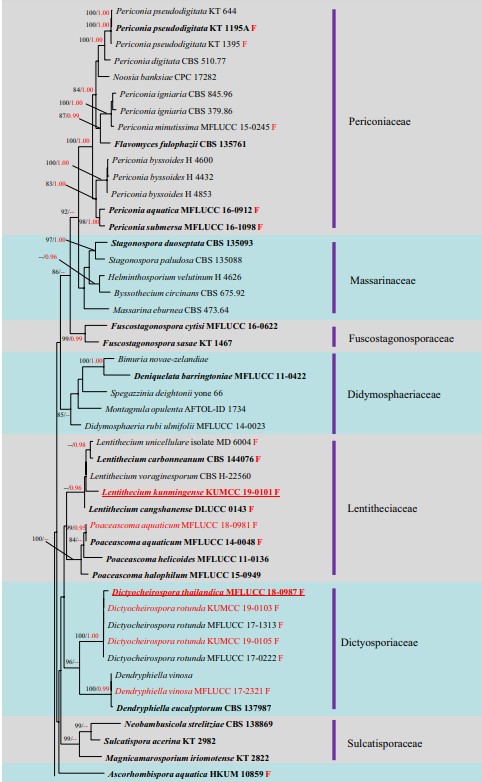Fusiformiseptata W. Dong, H. Zhang & K.D. Hyde, gen. nov.
Index Fungorum number: IF557938; Facesoffungi num- ber: FoF09283
Etymology: referring to fusiform spores of this genus
Saprobic on decaying wood submerged in freshwater.
Sexual morph: Ascomata black, scattered, immersed with a neck erumpent through host surface, ellipsoidal or obovoid, coriaceous, ostiolate. Neck subcylindrical or irregular, with flattened top, thick-walled, composed of two-layered perid- ium, with orange pigment. Peridium comprising several layers of dark brown, thick-walled, compressed cells of textura epidermoidea or irregular cells. Pseudoparaphyses numer- ous, cellular, broadly filiform, hyaline, septate, branched. Asci 8-spored, bitunicate, clavate, short pedicellate, apically rounded with well-developed ocular chamber. Ascospores biseriate, fusiform, hyaline, septate, asymmetrical, thin- walled.
Asexual morph: Undetermined.
Notes: – Multigene phylogenetic analysis shows that our new collection MFLU 18-1721 forms an independent line- age in Pleosporales (Fig. 2). Fusiformiseptata is therefore introduced for this freshwater taxon. Fusiformiseptata has a prominent neck with orange pigment on the inner wall and forms an arrow-shaped base to the ascomata. These char- acters are special in Pleosporales and warrant a new genus.

Fig. 2 Phylogram generated from maximum likelihood analysis of combined LSU, ITS, TEF and RPB2 sequence data for species of Dothideo- mycetes. Bootstrap values for maximum likelihood equal to or greater than 75% and Bayesian posterior probabilities equal to or greater than 0.95 are placed near the branches as ML/BYPP. Newly generated sequences are in red and ex-type strains are in bold. The new species intro- duced in this study are indicated with underline. Freshwater strains are indicated with a red letter “F”. Orders not treated in this study are compressed. The tree is rooted to Capronia pilo- sella AFTOL-ID 657 and Endo- carpon pallidulum AFTOL-ID 661 (Eurotiomycetes)
Species
